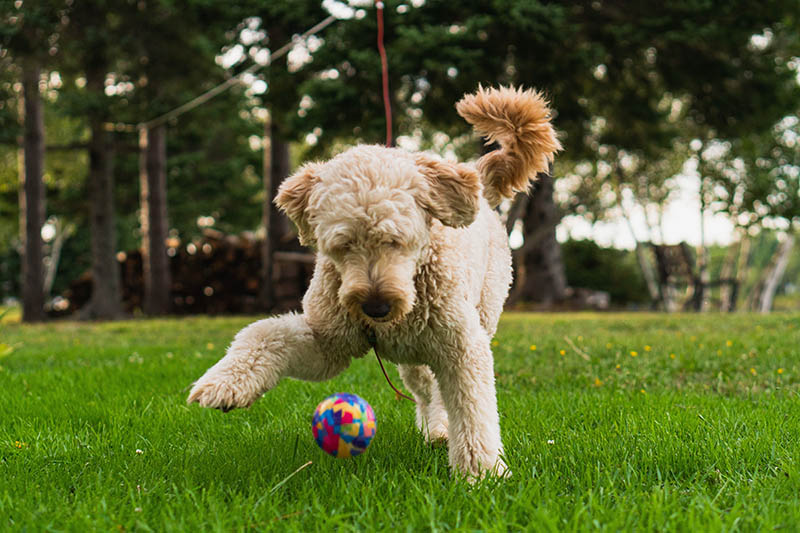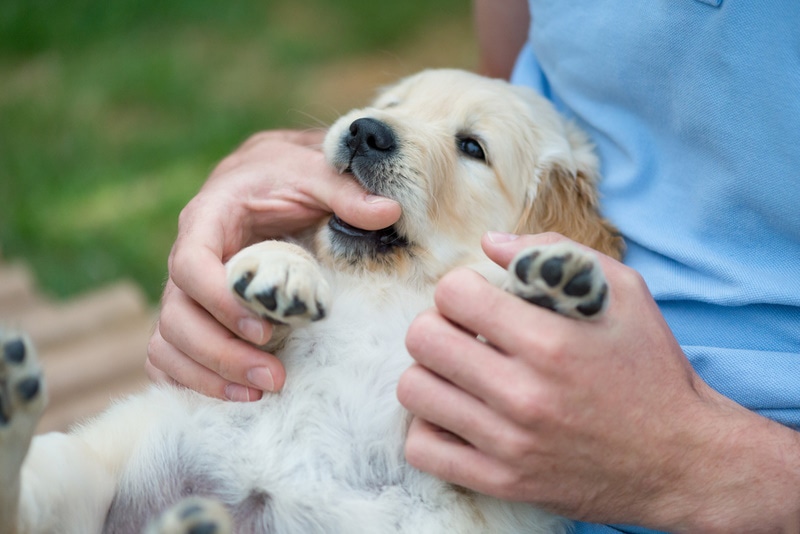Aromatherapy for Dogs: Does It Really Help? Vet Approved Advice
Updated on

Click to Skip Ahead
Aromatherapy is an age-old practice, using pleasantly aromatic herb-derived oils to soothe certain health conditions. The most common methods of administration are ingestion or inhalation. You might be thinking that your dog would enjoy some nice lavender on their bedding, and there may be some truth to that, with preliminary research suggesting that aromatherapy may have health benefits for your best furry four-legged friend.
HOWEVER, before you fire up your oil diffuser, it is imperative that you take time to do some research. Although aromatherapy may have its place in the world of canine complementary therapy, some essential oils can be irritant to our pets, whilst others are downright dangerous. Let’s take a closer look at the possible risks and benefits of aromatherapy for dogs, so you can decide if it’s right for you and your pet.
How Does Aromatherapy for Dogs Work?
The essential oils used in aromatherapy are highly concentrated organic compounds derived from certain aromatic plants. Lavender, chamomile, and myrrh are a few popular oils that are considered pet-safe for dogs in small doses. These oils come in a variety of products, from essential oils designed for diffusers to vials intended for direct ingestion, and it is important to know what form, dose, and applications are safe for our dogs.
What these essential oils all have in common are their extremely strong scents, which is where the magic happens. If you’ve ever smelled a familiar scent and been transported to another time or place, you already know the power of smell. By breathing or ingesting certain oils in very small, measured doses, your dog can potentially enjoy some of the therapeutic health benefits.
There’s very little scientific evidence to support any substantial effects on health, but vets may approve essential oil use to enhance some areas of your dog’s life. The key word when talking about complementary therapy is complementary: it is designed to accompany or enhance prescribed treatments, not replace them. You may find some vets are resistant to the idea, but many will happily help you work out a good balance between medical and natural remedies.

What Are the Different Types of Aromatherapy for Dogs?
There are countless essential oils marketed for humans and dogs alike, so it can be challenging to know which ones are really safe. As a basic rule, don’t use essential oils for humans with your dog. They aren’t formulated with their health in mind, and even oils that are considered safe for dogs may be mixed with carrier oils that could cause them irritation. Stick to reputable, well-known essential oils created for dogs. For an idea of which essential oils are safe to use, let’s peruse a brief list below.
- Lavender: Thought to reduce skin irritation and soothe anxiety in dogs with diluted applications.
- Valerian root and Vetiver: Common ingredients in many pet calming products.
- Chamomile: German chamomile is thought to have anti-inflammatory properties that can boost skin/coat health, while Roman chamomile is famous for soothing anxiety.
- Ginger: Ginger has anti-inflammatory properties that go great with chamomile, but it’s also known to ease nausea and supercharge immune systems.
- Frankincense: This Biblical essential oil is a great general-purpose oil to use for your dog, with immune-boosting power and anti-inflammatory properties.
What Essential Oils Are Poisonous for Dogs?
Not all essential oils are created the same, and what’s pleasant for us may be toxic for our dogs. To avoid accidentally exposing your dog to toxic essential oils, it’s critical that you familiarize yourself with what oils to avoid. Let’s check out below what essential oils to keep far, far away from your dog.
- Peppermint
- Pennyroyal
- Citrus (d-limonene)
- Cinnamon
- Sweet birch
- Tea tree
- Yarrow
You may see some of these ingredients on pet shampoos or grooming products, however, they are used in formulations and dilutions that render them non-toxic.

Aromatherapy Tips for Dogs
If you’re unsure of how to get started diffusing essential oils and unlocking their potential in your dog, here are a few valuable tips to help you on your way.
Tips for Using Essential Oils for Aromatherapy for Dogs:
- Less is more: Dogs have 40 times more olfactory receptors than humans: what smells strong to us may be unbearable to them.
- Choose a safe oil: Not all oils are safe or suitable for the same ailments. Carefully research which ones are both safe and effective in your situation.
- Dilute heavily: Even pre-diluted essential oils may be too strong for your dog’s liking and irritate their respiratory tract. Use about one drop of oil to nineteen drops (0.95 ml) of a carrier oil, like olive or coconut (1:20 dilution) unless specifically directed otherwise. If well tolerated, you could try going down to a 1:10 dilution (one drop to nine).
- Start slowly: Try a very diluted amount of oil in a diffuser to get your dog used to the scent and to gauge their reaction.
- Watch carefully: If you notice any signs of essential oil toxicity, immediately stop using it and seek advice from your vet or poisons hotline.
 Advantages of Aromatherapy for Dogs
Advantages of Aromatherapy for Dogs
Aromatherapy may have some positive, albeit difficult to measure, effects for our dogs. When used properly, aromatherapy can be a useful way to enhance your dog’s health without replacing traditional medicine, and could even increase its effectiveness. Let’s take a look at some of those benefits below.
Benefits of Aromatherapy for Dogs:
- Anxiety relief: Dogs suffering from separation anxiety or anxiety due to environmental factors like thunderstorms can experience significant relief from the right essential oils in low doses. eg. valerian or vetiver
- Improved skin and fur health: Essential oils applied to your dog’s fur can improve circulation, soothe inflamed skin, and promote healthy fur growth while fighting harmful microbes. eg. lavender
- Parasite repellent: While unproven in the realm of science, certain essential oils are anecdotally said to repel common parasites like fleas, ticks, or mites. They do not, however, kill or prevent them.
- Pain relief: Oils with analgesic or anti-inflammatory properties are useful supplements for dogs suffering from inflammation or arthritis. eg. ginger

Disadvantages of Aromatherapy for Dogs
Despite their benefits, essential oils used in aromatherapy can be very hazardous when used improperly or in high doses. Even so, we feel it’s important that you be aware there are some very big potential drawbacks to using essential oils for your dog. Let’s break those down in a quick list format below so you can judge the pros versus the cons yourself.
Drawbacks of Aromatherapy for Dogs:
- Toxicity: Some oils are toxic even in small amounts, but even pet-safe essential oils can cause acute toxicity. Pay very close attention to your dosing method and make sure the oil isn’t anywhere your dog can lick off.
- Irritation: Concentrated essential oils applied to the coat or skin can be irritating and cause skin rashes, itching, fur loss, and inflamed skin. Breathing them in can also be quite hazardous to their sensitive olfactory receptors and nasal lining.
- Lethargy: Essential oil poisoning signs come in a wide variety, but lethargy is a common one.
- Skin burning: Dogs that lick essential oils may display irritated skin around the mouth, inside it, and on the tongue.
- Ataxia: Dogs suffering from essential oil toxicity may act like they’re drunk and stumble around with little limb coordination.
- Depression: Listlessness and depression are common signs of essential oil poisoning in canines.
- Safe dosage limitations: In many cases, the dilution needed to render an oil safe for use in dogs may significantly reduce its effectiveness.
Frequently Asked Questions (FAQ)
How much scientific evidence is there to support essential oil aromatherapy for dogs?
Not a lot, and that’s why we can’t recommend aromatherapy as a substitute for scientifically proven and formulated medications. However, in some cases, aromatherapy can be a good way to passively soothe a fearful dog or to supplement conventional medicine. If you’re interested in whether aromatherapy would be good for your dog, bring up the topic the next time you visit your vet.
How can I avoid essential oil toxicity in my dog?
Do your homework and keep the toxic oils away. The best way to avoid any toxicity risks is to only ever bring home pet-safe essential oils. Diffusion is great, but make sure you choose a closed diffuser and put it somewhere your dog can’t reach it, and make sure you are using an appropriate dilution. Open diffusers may introduce too many fine liquid oil particles to the air, and if they get on your dog, it can be dangerous. Other than that, the best advice we can give you is to always err on the side of caution, use low and diluted doses, and check with your vet if you’re concerned.
A Quick Reference Guide to Safe & Unsafe Essential Oils for Dogs

- Lavender
- Chamomile
- Ginger
- Frankincense
- Myrrh
- Rosemary
- Valerian root
- Vetiver
- Cinnamon
- Clove
- Tea Tree
- Peppermint
- Pennyroyal
- Citrus
- Pine
- Wintergreen
Conclusion
Natural doesn’t always mean safe, but aromatherapy can have some tangible benefits for your dog if used cautiously. Avoid toxic oils and stick to the safe list. Be sure to dilute your oils before using them around your dog, and speak to your vet about the best and safest ways to include essential oils in your dog’s health management.
Featured Image Credit: Pixabay



 Advantages of Aromatherapy for Dogs
Advantages of Aromatherapy for Dogs











